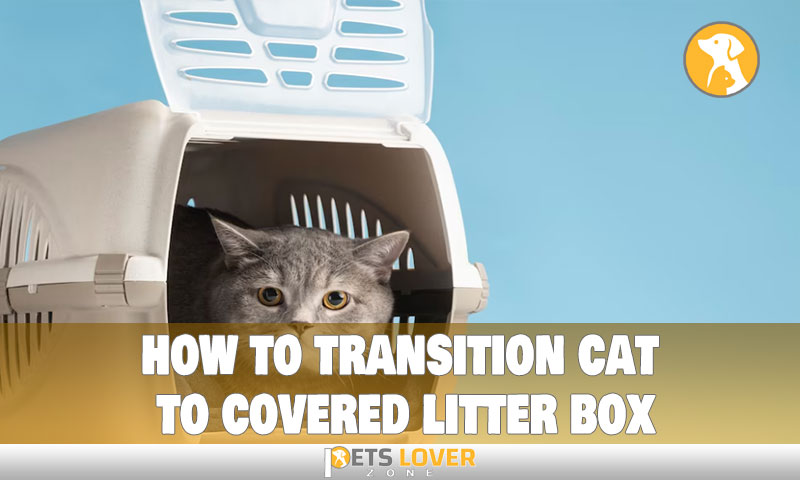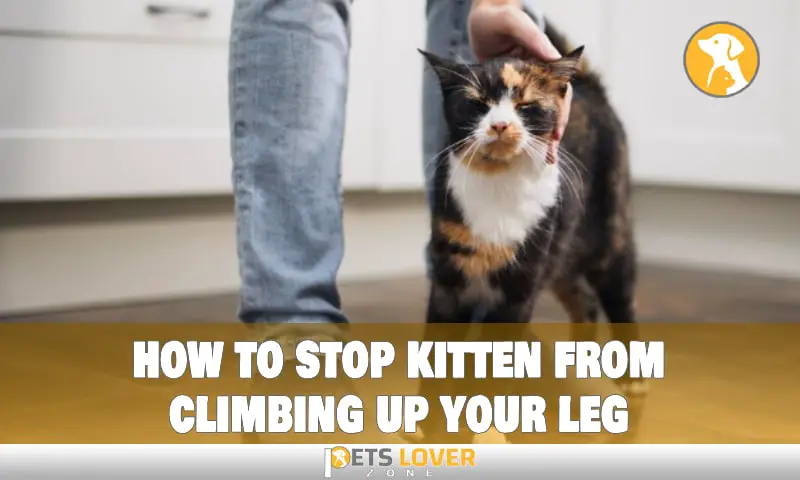To transition a cat to a covered litter box, gradually introduce the covered box by placing it next to the regular box and using the same litter. This will allow the cat to become accustomed to the new enclosure and feel comfortable using it.
Introducing a covered litter box to your cat can help contain odors and prevent litter tracking. However, cats can be sensitive to changes in their environment, so the transition should be done gradually. By following a few simple steps, you can successfully transition your cat to a covered litter box without causing any stress or anxiety.
In this article, we will explore the steps you can take to make the transition as smooth as possible, ensuring your cat’s comfort and well-being.
Why Should You Transition Your Cat?

Transitioning your cat to a covered litter box can bring a multitude of benefits for both you and your furry feline friend. By understanding the challenges of using an open litter box and how a covered litter box can overcome these obstacles, you’ll be equipped with the knowledge to make the change seamlessly.
Let’s take a closer look at the reasons why transitioning your cat to a covered litter box is worth considering.
The Challenges Of Using An Open Litter Box
- Tracking: Open litter boxes often result in scattered litter, making cleanup a never-ending battle.
- Odor: The open nature of traditional litter boxes allows unpleasant odors to permeate your living space.
- Privacy: Cats prefer privacy when doing their business, and open litter boxes may not offer the seclusion they crave.
- Mess: It’s not uncommon for cats to kick up litter or even accidentally aim outside the box, causing mess and frustration.
- Sensory overload: An open litter box can expose your cat to distractions or startling noises, hindering their ability to relax and do their business in peace.
How A Covered Litter Box Can Solve These Challenges
- Containment: A covered litter box acts as a barrier, containing litter within its confines and minimizing tracking issues.
- Odor control: The enclosed design of a covered litter box prevents unwanted smells from wafting through your home, keeping the air fresh and clean.
- Privacy and security: Cats thrive in a secure and private environment, and a covered litter box provides the perfect sanctuary for them to feel at ease.
- Reduced mess: With a covered litter box, you’ll experience fewer litter spills and accidental messes outside the box, simplifying cleanup.
- Reduced distractions: The enclosed design of a covered litter box shields your cat from external stimuli, allowing them to focus solely on their business.
By transitioning your cat to a covered litter box, you’ll create a more pleasant and comfortable environment for your furry companion while also enjoying the benefits of a cleaner and odor-free home. Ready to make the change? Let’s dive into the practical steps you can take to successfully transition your cat to a covered litter box.
Preparing For The Transition

Transitioning your cat to a covered litter box can be a smooth and stress-free process with a little preparation and patience. By following a few simple steps, you can help your feline friend make the switch comfortably and with ease.
In this section, we will discuss the key aspects of preparing for the transition.
Choosing The Right Covered Litter Box
When selecting a covered litter box for your cat, there are a few factors to consider. Keep in mind that not all cats may prefer a covered box, so it may require some trial and error to find the right fit.
Here are some points to keep in mind:
- Size: Opt for a covered litter box that is large enough for your cat to move around comfortably. Cats need space to turn around and dig, so choose a box that offers ample room.
- Entry and exit points: Look for a covered litter box with a wide enough opening for your cat to enter and exit effortlessly. Some boxes even come with removable doors, which can be beneficial during the transition period.
- Ventilation: Ensure that the covered litter box provides adequate ventilation to minimize odors and provide fresh air for your cat. Look for boxes with ventilation holes or filters to promote proper airflow.
Placing The Litter Box In The Appropriate Location
Finding the right location for your cat’s litter box is crucial for a successful transition. Cats are creatures of habit and prefer quiet and private spaces for their business. Consider the following points when determining the perfect spot:
- Accessibility: Choose an easily accessible location where your cat can reach the litter box without any hurdles. Avoid placing it in high-traffic areas or areas where your cat may feel cornered or trapped.
- Privacy: Cats value their privacy when using the litter box. Find a spot that offers seclusion, away from noisy appliances or busy areas of the house.
- Multiple boxes: If you have a multi-story home, it’s advisable to have litter boxes on each level for convenience. This ensures that your cat doesn’t have to travel long distances to find a suitable spot.
Gradually Introducing The Covered Litter Box To Your Cat
Introducing a covered litter box to your cat requires a gradual approach to help your feline friend adjust. Here are some steps to follow:
- Familiarize your cat with the box: Allow your cat to explore the covered litter box without any pressure. Place the box in a familiar spot and leave it uncovered initially to get your cat accustomed to its presence.
- Gradual covering: Once your cat is comfortable with the box, start gradually covering the top with a lightweight cover. This allows your cat to get used to the partially covered space at its own pace.
- Full covering: After a few days, you can fully cover the litter box. Keep an eye on your cat’s behavior to ensure they are adjusting well and don’t show signs of discomfort or anxiety.
By taking your time and being patient with the transition, you can help your cat adapt to the covered litter box smoothly. Providing a suitable box, finding the ideal location, and introducing it gradually will contribute to a successful transition for your feline companion.
Step-By-Step Transition Process
Transitioning your cat to a covered litter box can be a beneficial process for both you and your furry friend. It provides a sense of privacy for your cat while also helping to contain any potential litter mess. However, it’s important to approach this transition with care and patience to ensure your cat adjusts comfortably.
In this step-by-step process, we will guide you through the gradual transition from an uncovered to a covered litter box, ensuring your cat’s comfort throughout the journey.
Starting With A Partially Covered Litter Box:
- Begin by introducing a partially covered litter box, allowing your cat to become familiar with the concept of a limited enclosure.
- This will provide a sense of security for your cat while still allowing them to see their surroundings.
Explaining The Benefits To Your Cat:
- Provide comfort and privacy: A covered litter box offers your cat a private space to do their business away from prying eyes.
- Contain litter mess: The cover helps prevent litter from being scattered around, keeping your home cleaner.
- Reduce odor: The cover can help trap odors, providing a more pleasant environment for both you and your cat.
Getting Your Cat Used To The Partial Covering:
- Place the partially covered litter box in a quiet and easily accessible area where your cat feels safe.
- Allow your cat to explore the new setup at their own pace, giving them time to adjust to the partial covering.
Gradually Increasing The Level Of Coverage:
- Once your cat is comfortable with the partially covered litter box, gradually increase the level of coverage.
- This can be done by adding a removable cover with small openings or flaps to provide additional privacy.
Gradually Adding More Cover To The Litter Box:
- As your cat becomes accustomed to the increased coverage, you can gradually add more cover to the litter box.
- Keep an eye on your cat’s behavior and comfort level during each stage of the transition.
Monitoring Your Cat’s Comfort And Behavior:
- Observe how your cat responds to the covered litter box. Look for signs of stress or discomfort, such as avoiding the litter box or struggling to use it properly.
- If your cat shows signs of distress, consider slowing down the transition process or seeking guidance from a veterinarian.
Encouraging Positive Associations:
- Make the covered litter box a positive and enticing space for your cat. Keep the litter box clean, as cats prefer a hygienic environment.
- Use a litter that your cat is comfortable with and sprinkle some familiar litter on top of the new litter in the covered box.
Placing Treats Or Toys Near The Litter Box:
- Encourage your cat to associate the covered litter box with positive experiences by placing treats or toys near the box.
- This will help create a positive association and make the transition more enjoyable for your cat.
Rewarding Your Cat’s Use Of The Covered Litter Box:
- Praise and reward your cat every time they successfully use the covered litter box.
- This positive reinforcement will reinforce the idea that using the covered box is a desirable behavior.
Remember, every cat is unique, and the transition process may take time. Be patient, provide plenty of reassurance, and monitor your cat’s comfort throughout the transition. With a gradual and gentle approach, your cat will soon feel comfortable using their new covered litter box.
Addressing Cat Concerns And Anxieties
Transitioning your cat to a covered litter box can be a beneficial move for both you and your feline friend. However, it’s essential to address any concerns or anxieties your cat may have during this process. By understanding potential litter box aversions and implementing strategies to reduce anxiety and promote a calm environment, you can make this transition smoother.
Let’s dive into how to address these concerns and anxieties effectively.
Addressing Potential Litter Box Aversions
To successfully transition your cat to a covered litter box, it’s crucial to address any potential litter box aversions they may have. Some key points to consider include:
- Gradual transition: Introduce the covered litter box gradually by placing it near the existing open litter box. This allows your cat to become familiar with the new box and adjust at their own pace.
- Encourage exploration: Place treats or toys near the covered litter box to make it a positive and inviting space for your cat. Their curious nature will likely lead them to explore the new box on their own.
- Maintain cleanliness: Cats are notoriously clean animals, so ensuring the litter box remains clean and odor-free is vital. Regular scooping and thorough cleaning will promote a positive association with the covered box.
Common Reasons For Litter Box Aversions
Understanding the reasons behind litter box aversions can help you address them effectively. Some common reasons include:
- Size restrictions: If the covered litter box is too small, it may feel cramped and uncomfortable for your cat. Opt for a larger size that allows them to move around and dig comfortably.
- Odor trapping: Covered litter boxes can sometimes trap odors, which may deter your cat from using them. Choose a box with proper ventilation or invest in litter that controls odor effectively.
- Privacy preferences: While covered litter boxes provide privacy, some cats may prefer an open space where they can easily monitor their surroundings. Observing your cat’s preferences will help you make the right adjustments.
Steps To Address And Solve Aversions
To address and solve any litter box aversions, consider the following steps:
- Monitor behavior: Observe your cat’s behavior around the covered litter box. Are they hesitant, stressed, or completely avoiding it? This observation will help you tailor your approach accordingly.
- Gradual adjustment: If your cat shows aversion, try removing the cover temporarily and reintroducing it later. This gradual adjustment can help them get comfortable with the new box.
- Experiment with litter type: Some cats may have specific preferences when it comes to litter texture or scent. Experimenting with different litter types can help you find the one that your cat prefers.
Reducing Anxiety And Stress
Transitioning to a covered litter box can sometimes induce anxiety or stress in your cat. Here are some strategies to alleviate these feelings:
- Vertical space: Provide vertical spaces, such as cat trees or shelves, for your cat to climb and observe their environment. This helps create a sense of security and reduces anxiety.
- Positive reinforcement: Praise and reward your cat when they use the covered litter box successfully. Positive reinforcement helps them associate the new box with positive experiences.
- Play and interaction: Engage your cat in regular play sessions and provide opportunities for interaction and bonding. This helps reduce stress and anxiety overall.
Creating A Calm And Safe Environment
Creating a calm and safe environment is crucial for your cat’s overall well-being during the transition. Consider the following tips:
- Quiet location: Place the covered litter box in a quiet and low-traffic area of your home. This minimizes disturbances and provides privacy for your cat.
- Multiple litter boxes: If you have multiple cats, ensure you have enough litter boxes for each cat, including both covered and open options. This prevents competition or overcrowding.
- Adequate resources: Provide an ample supply of fresh water, food, and scratching posts to meet your cat’s basic needs. This promotes a sense of security and reduces stress.
Remember, each cat is unique, and their transition to a covered litter box may vary. Patience, observation, and gradual adjustments will ultimately help your cat feel comfortable and at ease with their new litter box.
Maintaining The Covered Litter Box
Transitioning your cat to a covered litter box can bring numerous benefits, from reducing odors to providing your furry friend with privacy. However, it’s essential to maintain the covered litter box properly to ensure your cat’s comfort and hygiene. Regular cleaning and monitoring of your cat’s behavior and health are key to maintaining a clean and inviting litter box environment.
Let’s explore the importance of cleanliness and the steps for proper cleaning and maintenance.
Regular Cleaning And Maintenance
Keeping the covered litter box clean is crucial for your cat’s overall well-being. Regular cleaning ensures that your cat feels comfortable using the litter box and reduces the risk of unpleasant odors permeating your home. Here are a few key points to keep in mind:
- Scoop the litter box daily: Removing waste promptly reduces the chances of your cat stepping in soiled litter and minimizes odor buildup.
- Replace litter regularly: Depending on the type of litter and your cat’s habits, you may need to completely replace the litter every 1-2 weeks. This helps maintain freshness and cleanliness.
- Wipe down the litter box: Use a pet-safe disinfectant or warm soapy water to clean the inside and outside of the litter box, ensuring it remains free from bacteria and odor-causing germs.
Importance Of Cleanliness For Your Cat’S Comfort
A clean litter box is essential for your cat’s comfort and overall well-being. When the litter box is well-maintained, your cat will feel more inclined to use it consistently. Here are a few points to consider:
- Cats are naturally clean animals, and they prefer using a clean litter box. Regular cleaning will help prevent any aversion or reluctance to use the covered litter box.
- A dirty litter box can lead to stress and discomfort for your cat, potentially causing them to avoid using it altogether. Maintaining cleanliness ensures that your cat feels comfortable and confident while using the litter box.
Steps For Proper Cleaning And Maintenance
Maintaining a covered litter box doesn’t have to be a daunting task. By following these steps, you can ensure your cat has a clean space to fulfill their litter box needs:
- Start by removing any solid waste daily using a litter scoop.
- Check the litter box for urine clumps and remove them promptly to prevent odor buildup.
- Thoroughly clean the litter box at least once a week, using a pet-friendly disinfectant or warm soapy water.
- Rinse the litter box thoroughly and allow it to air dry before adding fresh litter.
Monitoring Your Cat’s Behavior And Health
While regular cleaning is vital, it’s equally important to monitor your cat’s behavior and health in relation to the covered litter box. Some key points to consider include:
- Observe your cat’s litter box usage patterns. Sudden changes in the frequency or duration of visits may be indicative of underlying health issues and should be addressed promptly.
- Watch for any signs of discomfort or aversion when your cat enters or exits the covered litter box. This could mean that adjustments are necessary to ensure their comfort and ease of use.
- Keep an eye on your cat’s overall well-being. A clean and maintained litter box is just one aspect of their care, and monitoring their behavior and health holistically will provide valuable insight into their overall happiness and comfort.
By maintaining a clean and inviting covered litter box, you can provide your cat with a comfortable and hygienic space to attend to their needs. Regular cleaning, proper maintenance, and monitoring of your cat’s behavior are key to ensuring their ongoing satisfaction with their litter box experience.
FAQ
How Do I Introduce My Cat To A Covered Litter Box?
To introduce your cat to a covered litter box, start by leaving the cover off and gradually adding it over time.
Why Is My Cat Hesitant To Use The Covered Litter Box?
Cats may be hesitant to use a covered litter box due to a lack of privacy, smell confinement, or size limitations.
How Can I Make A Covered Litter Box More Appealing?
Make a covered litter box more appealing by keeping it clean, using the litter your cat prefers, and providing adequate ventilation.
What Should I Do If My Cat Refuses To Use The Covered Litter Box?
If your cat refuses to use the covered litter box, try removing the cover temporarily or providing an uncovered alternative.
Conclusion
Transitioning your cat to a covered litter box can be a smooth process with the right approach. By implementing gradual changes and considering your cat’s preferences, you can make the transition a positive experience for both of you. Start by choosing a covered litter box that allows your cat to comfortably enter and exit.
Introduce the new box alongside the existing one so your cat can become familiar with it. Gradually decrease the size of the opening on the existing box while increasing it on the new one. Make sure to gradually remove the old box once your cat is comfortable using the covered litter box.
Provide positive reinforcement and rewards to encourage your cat’s acceptance. Remember, patience is key throughout this transition, as every cat is different. Before you know it, your cat will be happily using their new covered litter box, ensuring a cleaner and tidier space for both of you.






